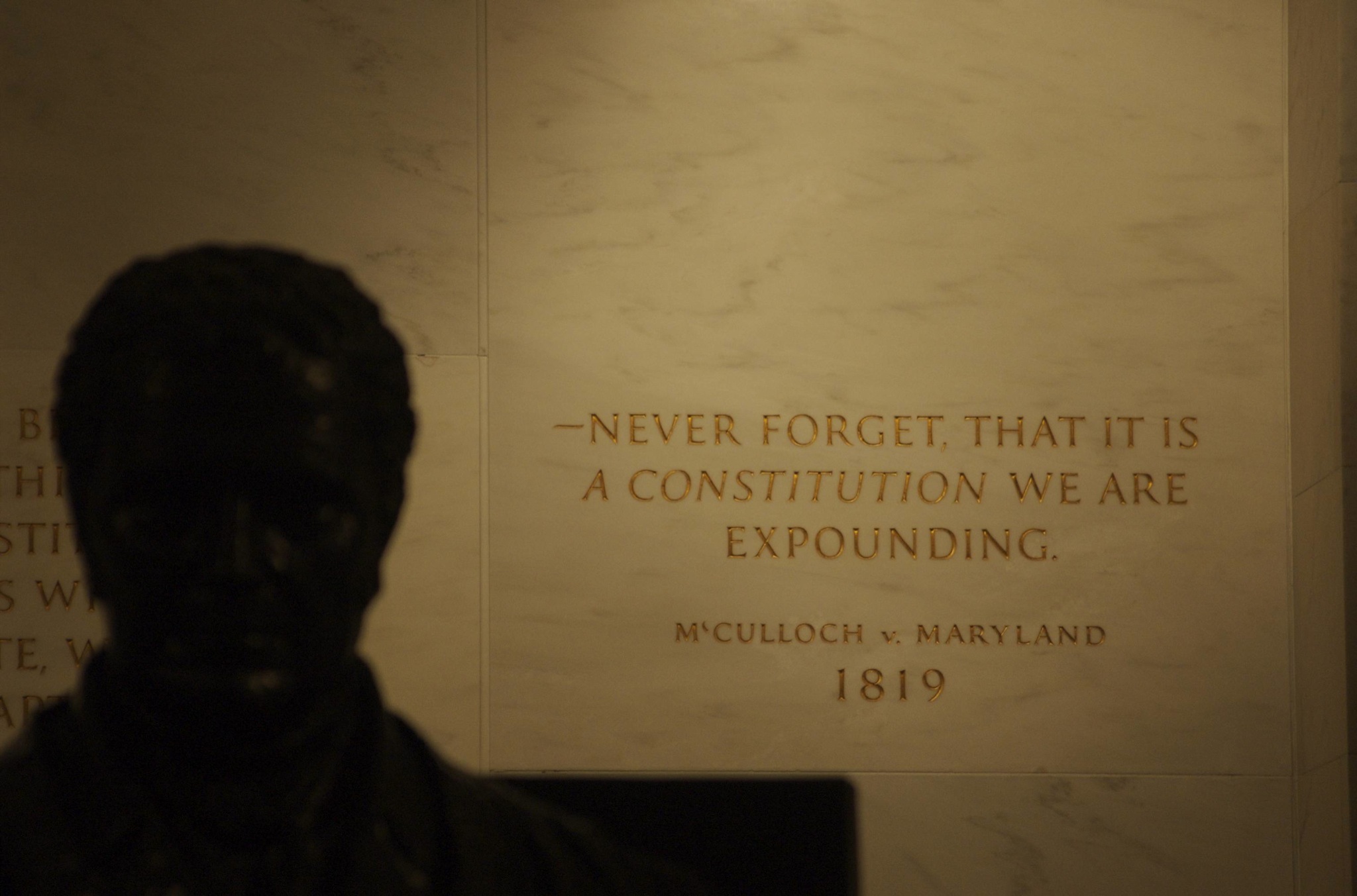
This essay is part of an ongoing partnership between Law & Liberty and the James Wilson Institute on Natural Rights and the American Founding. Essays in this series explore the rich interplay among law, governance, and political philosophy.
Holden Tanner began this symposium with a clear, forceful, and provocative call to restore legal conservatism through natural law decision-making in state courts. In his response, Josh Hammer agrees with much of Tanner’s analysis, finding “a great deal in common with [his own writing on] common good originalism.” I also find much in Tanner’s argument that is consistent with my scholarship on originalism and legal conservatism. But as is customary for a symposium such as this, I will focus more on the divergences among the three of us—divergences that may prove significant in shaping the substance and strategies of legal conservatism in the coming years.
The Political Background
The 2016 election had a destabilizing effect on American politics, challenging electoral coalitions and party platforms. This unsettling effect was felt most profoundly within “the conservative movement”— a group of scholars, pundits, and activists largely aligned with the Republican Party’s pre-Trump positions on globalism, foreign policy interventionism, and the “proposition nation.”
The destruction wrought by Trump’s “America First” movement quickly migrated to the legal conservative movement. In 2016, only six law professors in the entire country were willing to endorse the Republican nominee, whereas many of the nation’s leading conservative legal scholars joined a statement “Originalists Against Trump,” endorsing Hillary Clinton as the better candidate. At the time, I was one of the few legal scholars who welcomed the Trumpian shift as “mark[ing] the beginning of a new American Right,” one potentially more tethered to preserving local communities and cultural traditions.
Over the last five years, however, many legal conservatives have started to embrace the so-called “New Right.” I would of course like to think my writing has played a part in that, but the most critical event in inciting this change was the Bostock decision. By showcasing how statutory textualism could be used by purportedly conservative Justices to achieve progressive and seemingly non-textual results, the Bostock decision, Senator Josh Hawley concluded, “represents the end of the conservative legal movement, or the conservative legal project, as we know it.” Likewise, Josh Hammer, though formerly a vocal critic of Trump and one of the signatories of Originalists Against Trump, wrote in response to Bostock that the decision revealed “the moral and intellectual bankruptcy of the conservative legal movement.” Amidst rising frustration with the trajectory of legal conservatism, and the concomitant rise of Adrian Vermeule’s “common good constitutionalism,” there is now a burgeoning movement to reconsider conservative modes of constitutional interpretation.
This is the background against which Holden Tanner and Josh Hammer posit their arguments on restoring legal conservatism through natural law and state courts.
Tanner’s Strategy: The States-First Approach
Tanner views state courts as the best vehicles to restore a common-law jurisprudence grounded in natural law, because “when the states have accepted the natural law as an integral part of American legal reasoning, the federal courts should follow their model.” Here, Tanner seems to be using the word “should” in a predictive as opposed to a normative sense. Tanner makes this prediction on the basis of history— i.e., some successful socio-legal movements have started their litigation campaigns by using state law in state courts before advancing similar arguments under federal law in the federal judiciary.
Tanner uses the example of desegregation, but it is important to note that this misrepresents the NAACP strategy. The NAACP did not seek to create a national consensus through state courts and state law. Rather, the NAACP strategy was to challenge segregation directly under the Fourteenth Amendment—meaning that, even if brought originally in state courts, the claims would be appealable to the U.S. Supreme Court, an institution that at the time was much more liberal on racial issues than local state judges.
The more direct analogue is the same-sex marriage movement, which did use this “states-first strategy.” This strategy worked in the gay-rights context, however, only because there was a larger cultural movement operating concurrently with the litigation campaign. Indeed, the first state supreme court decision finding a right to same-sex marriage was Goodridge v. Department. of Public Health (2003), and it almost certainly would not have produced Obergefell v. Hodges (2015) were it not for the cultural transformation undertaken through media, academia, and entertainment in those intervening 12 years.
The consequence of decisions like Everson and Engel was that all the public schools in the nation would be tugged by the gravitational pull of the nation’s most secular elements.
I don’t make these points about the judicial politics of desegregation and gay rights to quibble with Tanner. Rather, I make these points to illustrate a larger problem within legal conservatism, a critical feature of why I believe it has failed as a movement.
As I wrote in response to the A Better Originalism manifesto, the authors missed the mark in that manifesto because they “proceed[ed] the way that legal conservatives have operated for the last two generations—as though tinkering with a method of legal interpretation is the key to victory.” That is, they neglected the cultural conditions that are necessary for their arguments to work.
A successful socio-legal movement must engage within rather than push against the prevailing cultural norms. The NAACP, for example, was acutely aware of nation-wide repugnance toward racial mixing, which is why the organization began its litigation campaign in the domain of property law, far from the realm of the most controversial areas of racial integration—namely, interracial marriage and K-12 public education. Lambda Legal was similarly aware of the societal distaste for normalizing homosexuality, which is why the organization began its litigation strategy dealing with matters of bodily autonomy and public accommodations, far from the realm of same-sex marriage. Legal liberals, in other words, had the discipline to litigate strategically and to operate within the confines of the social facts of American culture.
Any effort to restore a natural law jurisprudence must come to grips with our social facts—namely, that we inhabit a nation in the midst of an unprecedented decline in church membership, a nation that is the world’s biggest pornography peddler, and a nation that leads the world in the rate of single-parent households. These conditions all must change before any effort to restore natural law can get off the ground.
Hammer’s Endgame: Federal Common Law
Hammer reluctantly accedes to Tanner’s states-first strategy, viewing it as a second-best option “due to the sheer unlikelihood of ever overturning Erie Railroad v. Tompkins.” For non-lawyers, I should explain that Erie Railroad v. Tompkins (1938) is a famous civil procedure case, holding that when federal courts exercise “diversity jurisdiction,” they must apply state law, as opposed to the “federal common law” method announced by Justice Joseph Story in Swift v. Tyson (1842). Because Hammer prefers Justice Story’s approach, Hammer agrees to Tanner’s strategy only as a conditional matter— i.e., “while overturning Erie remains a mere pipe dream.”
Hammer’s view of Erie is puzzling. Of all the Supreme Court decisions conservatives should “dream” about overruling, Erie should be pretty low on the list, perhaps just below the Legal Tender Cases (1871). Hammer’s view of Erie is made all the more puzzling by his treatment of Everson v. Board of Education (1947) and Engel v. Vitale (1962). Hammer calls these Establishment Clause decisions “secularizing constitutional abominations,” which they certainly are, but what made these cases “constitutional abominations” is not merely that they were based on a half-baked notion of a “wall of separation.”
The real problem, which is the problem that Willmoore Kendall identified shortly after the Engel decision, is that these decisions subjected local school boards to a singular church-state standard. In Kendall’s words, “The real significance and danger of the ‘prayer’ decisions lies . . . in the attempt to lay down a general rule on religious observances in the schools where formerly there was none—and to accomplish this by setting aside a universally understood (if never articulated) general rule on another matter, namely: Let the people of the local community work the matter out, as part of their general problems of living together on their little portion of American real estate.”
The consequence of decisions like Everson and Engel was that all the public schools in the nation would be tugged by the gravitational pull of the nation’s most secular elements. In other words, the most Christian parts of the country, namely the American South, would be subject to the cultural norms of New York City. This is a “constitutional abomination” because it is in direct contravention of the distribution of powers provided in the 1787 Constitution and the decentralized promise of the Establishment Clause.
The centralizing jurisprudence that Hammer would like to restore in overruling Erie is precisely what made Everson and Engel possible. And it is precisely what made Everson and Engel wrong.
Hammer defends his centralizing jurisprudence, however, by appealing to the broad language of the Preamble, which he sees as the “telos of the American regime.” This, it seems to me, gets the Preamble wrong. As Timon Cline has persuasively argued, Hammer’s use of the Preamble does not account for the structural guarantees in the 1787 Constitution. In Cline’s words, “Hammer does not consider which community is in view when the Preamble invokes a common good synonym insofar as he does not acknowledge the structural limitations of its scope.”
This concern about community is particularly apt in modern-day America. It is important to recall that in the early 19th century the Federalists supported federal common law as part of a larger political battle. As Professor Newmyer writes in his excellent biography of Justice Story, “federal common-law jurisdiction meant a strengthened federal judiciary,” which meant more power for the Federalists, who tended to come from the urban and financial centers of the young country. It made political sense for the party of urban wealth in the 19th century to enlarge federal common law and thereby empower the federal judiciary, the institution over which they exercised the most control. It does not make political sense for the Republicans of the 21st century to do that, for Republicans, as much as they may deny it, have power only outside of the nation’s urban and financial centers.
Why State Courts Matter
While there are substantial differences between Tanner’s and Hammer’s visions, they have one thing in common: They both view state courts as mere vehicles for the restoration of federal power. This inverts the Founding. The states abandoned the Articles of Confederation and created the U.S. Constitution for the limited purpose of giving the federal government power over two policy areas the states could not collectively handle—the regulation of inter-state commercial transactions and the protection of national security. The federal government was created as a limited enterprise to strengthen the states.
For both Hammer and Tanner, state courts are strategic expedients, useful to our constitutional system only now that legal conservatism no longer seems ascendant. And instead of resuscitating the states to restore our original 1787 design, they wish to resuscitate the states to strengthen the federal judiciary, the institution that has contributed more than any other to obliterating the original distribution of powers.
For many conservatives, however, state courts matter not as mere expedients; state courts matter because states matter. And states matter not only because of the constitutional history but also because states represent the most powerful vehicles for the expression of the freedom of association, the most fundamental liberty to the Founders.
But even for conservatives who think about states more strategically, as Tanner and Hammer do, they should be careful to insulate state courts from the national machinery, for state courts might not merely represent the first judicial path toward conserving the American way of life. They may be the only one.





